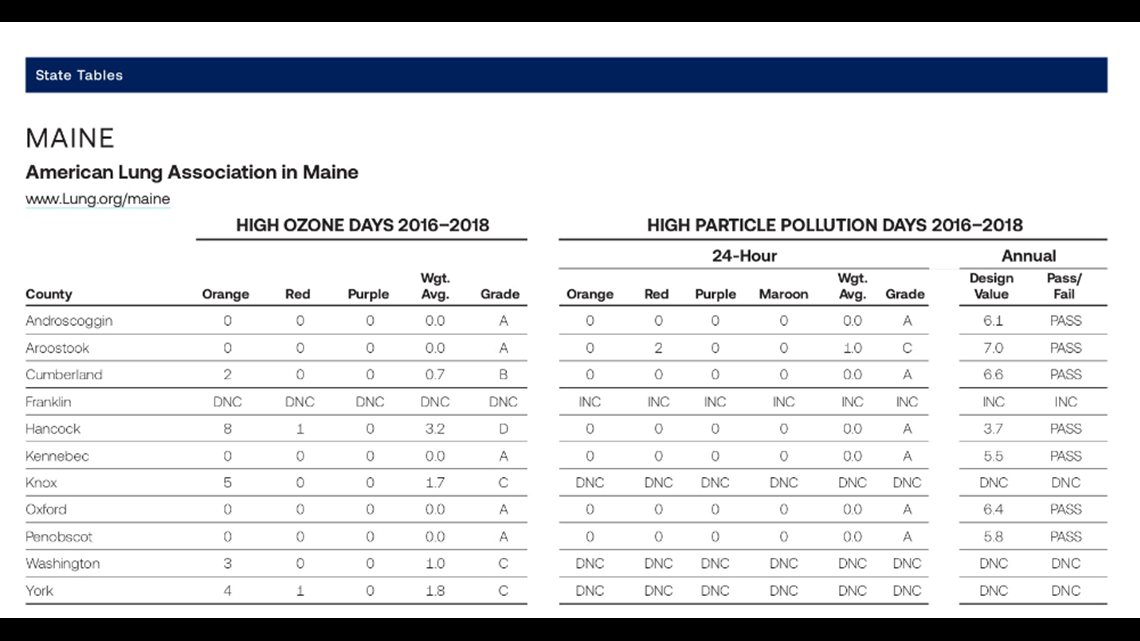MAINE, Maine — The American Lung Association released its annual air quality “report card” on Tuesday, which tracks Americans’ exposure to unhealthful levels of particle pollution and ozone during a three-year period.
This year’s report covers 2016, 2017 and 2018, the years with the most recent quality-assured data available collected by states, cities, counties, tribes and federal agencies.
In a press release, the American Lung Association says, "As the country continues to grapple with the COVID-19 pandemic, improving air quality is more important than ever – as studies have shown air pollution harms lung health, and emerging research links long-term exposure to particle pollution to increases in the death rate among COVID-19 patients. Once again, the report found that nearly half of all Americans were exposed to unhealthy air in 2016-2018."
The American Lung Association’s 2020 “State of the Air” report found that air quality in Maine slightly improved across the state and in most reporting counties.


**DNC stands for did not collect. INC stands for incomplete data set.
The Bangor metro area once again ranked as one of the cleanest cities in the nation in all three categories within the report.
It's a drastic contrast to the Portland-Lewiston-South Portland metro area, which ranked in the top 100 most polluted cities for ozone.
The only county found to have declined in Maine is Washington, which went from a B grade on ozone to a C grade.
The report comes at a time in which health officials are closely focusing on air quality.
"For many Americans, the COVID-19 pandemic has illustrated just how important lung health really is," said Dr. Marguerite Pennoyer, a Scarborough physician specializing in allergy and immunology. "There is no short cut, no alternative to breathing. We must do more to protect our lungs from anything that puts our ability to breathe at risk, be it a virus, tobacco smoke, or air pollution."
Report taken from American Lung Association Press release:
Ozone Pollution:
Compared to the 2019 report, counties in Maine experienced fewer unhealthy days of high ozone in this year’s report. Grades in Androscoggin and Penobscot remained As, while Cumberland and York County grades improved from a C to a B, and from a D to a C, respectively.
“Ozone pollution can harm even healthy people, but is particularly dangerous for children, older adults and people with lung diseases like COPD or asthma,” said Pennoyer. “Breathing ozone-polluted air can trigger asthma attacks in both adults and children with asthma, which can land them in the doctor’s office or the emergency room. Ozone can even shorten people’s lives.”
In the state’s metro areas, Bangor reported no unhealthy days. Portland-Lewiston-South Portland did show some improvement reporting its lowest ever ozone – and improving from the 82nd most polluted city in the nation last year, to the 91st in this year’s report.
This report documents that warmer temperatures brought by climate change are making ozone more likely to form and harder to clean up. Significantly more people suffered unhealthy ozone pollution in the 2020 report than in the last three “State of the Air” reports.
Particle Pollution:
“State of the Air” 2020 found that year-round particle pollution levels in both metro areas and every reporting county were slightly lower than in last year’s report, showing across the board improvement.
“Particle pollution can lodge deep in the lungs and can even enter the bloodstream. It can trigger asthma attacks, heart attacks, and strokes and cause lung cancer,” Pennoyer. Particle pollution comes from coal-fired power plants, diesel emissions, wildfires, and wood-burning devices.
“Year-round particle pollution levels had dropped in recent years thanks to the cleanup of coal-fired power plants and the retirement of old, dirty diesel engines. However, the increase we’ve seen nationally in particle pollution in this year’s report is a troubling reminder that we must increase our efforts to reduce this dangerous pollution,” said Boucher.
“State of the Air” 2020 also tracked short-term spikes in particle pollution, which can be extremely dangerous and even lethal. The report found that Maine’s A grades were consistent with last year’s report, with the exception of Aroostook, which saw its grade drop from a B to a C, due to an increase of days where short-term particle pollution reached unhealthy levels.

